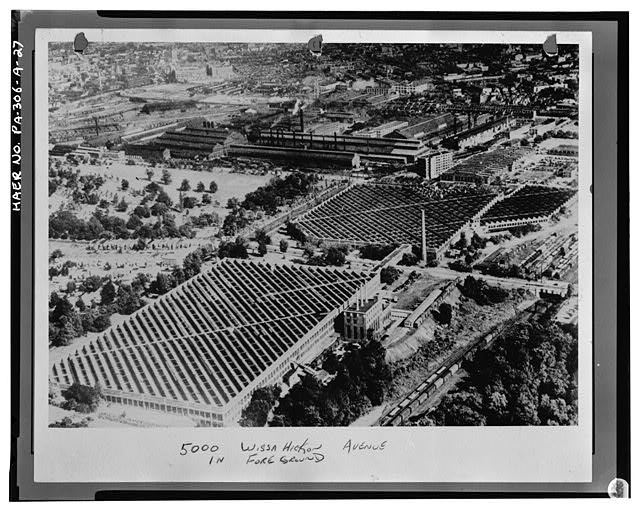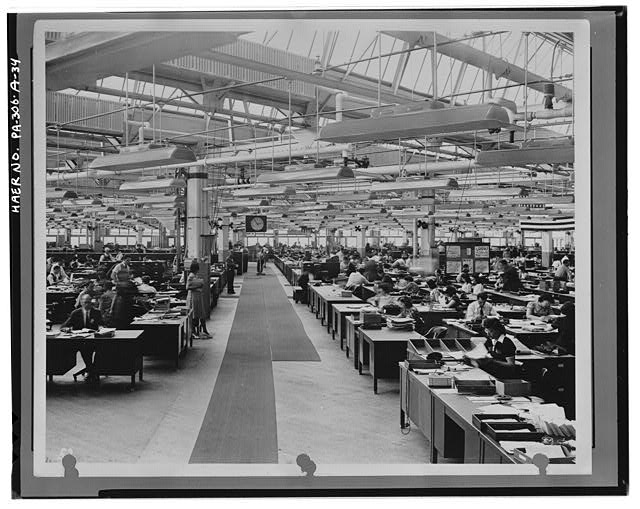
Aerial view of trusses designed to incorporate natural light. Designed by Ballinger in 1923. HAER
Atwater Kent Radio Plant, 1923
5000 Wissahickon Avenue, Philadelphia PA
(corner of Abbottsford Road)
© Harold E. Spaulding,
Workshop of the World (Oliver Evans Press,
1990).
In 1902, Arthur Atwater Kent
constructed a plant at 6th and Arch Streets in
Philadelphia to make interconnecting home telephones and
small voltmeters. Within the next three years, he began
developing automobile components such as open circuit
ignition systems, switches, and timers. Shortly
thereafter, he moved his plant to East Stenton Avenue,
near the Fisher Station and with 125 employees engaged
wholly in the production of automotive ignition devices.
Later, he diversified into the production of lighting
systems and during World War I he manufactured fire
control equipment for gunnery. After the War, he turned
his attention first to the manufacture of radio
components and ultimately, in 1923, to the production of
his first five-tube receiver. 1
The present plant was constructed in 1923 on a fifteen
acre site. Designed by Ballinger Architects and Engineers
of Philadelphia, the plant’s hallmark was an
interesting truss design, patented by Ballinger. The
truss featured a deep, long span with natural lighting
incorporated into the truss structure.
2
In 1928, an
additional plant was built across Abbottsford Road on
seventeen acres. 3
The two plants
were connected by an enclosed bridge over the road.

Interior view of
trusses incorporating natural light. HAER
During the 1927-28 season, the Atwater Kent Company
produced over one million radios and became the largest
manufacturer of radios in the world. During the 1930s,
the Depression forced the radio industry to change as
large-scale, mass-produced, cheaply made radio sets
became available. During that time, organized labor
introduced more concerns for manufacturers and demanded
more from their employers. In 1935, Atwater Kent decided
to quit the radio business and he closed down operations
within a year.
By 1936, the Philadelphia Storage Battery Company, later
known as Philco, took over the complex. After World War
II, Philco made refrigerators at the plant. After Philco
became a part of Ford Aerospace, the plant shut down.
The plant now sits vacant but is presently being
refurbished by developers Brian and Michael O'Neill, who
plan to offer low-cost rental space to light industry.
When U.S. Route 1, the Roosevelt Extension, was
constructed, the bridge between the two plants was
destroyed.
1 Dictionary
of American Biography, 1946-1950, (New York, 1950), pp.
451-453.
2 See Patent Reissue No.
15,133, dated June 28, 1921, found at the Ballinger
Company's archives in Philadelphia.
3 It is now occupied by
the Veterans Administration.
Update May
2007 (by
Muriel Kirkpatrick):
The
original 1923 building has been converted to a center
housing several operations, including the Wissahickon
Charter School, where the Philadelphia Flying Phoenix
Dragonboat team holds indoor practice. One major
component is Material Culture, a retail operation
established in 1996 in a two-story building that was used
as train shed for the Atwater Kent plant. The first floor
houses furnishings and decorative objects from Africa and
Asia. On the second floor, light from the saw tooth roof
illuminates an array of rugs.
In 2006, the Philadelphia Design and Distribution Center,
a 677,000-square-foot building, was sold to a New York
partnership. At that time it was 94 percent occupied by
20 tenants. It was known as the storage location for
Philadelphia’s voting machines. (Based on articles
from the Philadelphia Business Journal published in
February 1999, and July 2006).
In the mid 1990s the second 1928 building, across
Abbottsford Road, was demolished for new construction.
The building cornerstone was opened by a group of
individuals from the preservation community, including
members of the Atwater Kent family and a representative
of the Atwater Kent Museum, Philadelphia’s museum
of city history.
Originally housing the Franklin Institute, the Atwater
Kent Museum building on South 7th Street was almost
demolished when the institute moved to the Benjamin
Franklin Parkway in 1933. An excerpt from the
museum’s website continues the history:
"In
1936 the newly elected Mayor S. Davis Wilson and Frances
Wistar, president of the Philadelphia Society for the
Preservation of Landmarks, asked inventor and radio
pioneer A. Atwater Kent to purchase the building and
create a history museum for the City of Philadelphia.
Wilson and Wistar were joined in their efforts by the
president of the University of Pennsylvania, the director
of the Historical Society of Pennsylvania and the
president of the Franklin Institute. Kent agreed, and in
1938 the building was purchased and given to the city
with three conditions. It was to be dedicated to the
history of Philadelphia, named for Kent and be free to
the public.(In 1994 a City Ordinance allowed the museum
to charge an admission fee). On April 19, 1941, the
Atwater Kent Museum was formally dedicated in ceremonies
attended by the mayor and over 100 city officials."
See also:
Historic American Engineering Record -
Atwater Kent
Atwater Kent Museum - a brief history of
Atwater Kent Manufacturing Company and links to
Atwater Kent radio websites